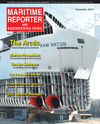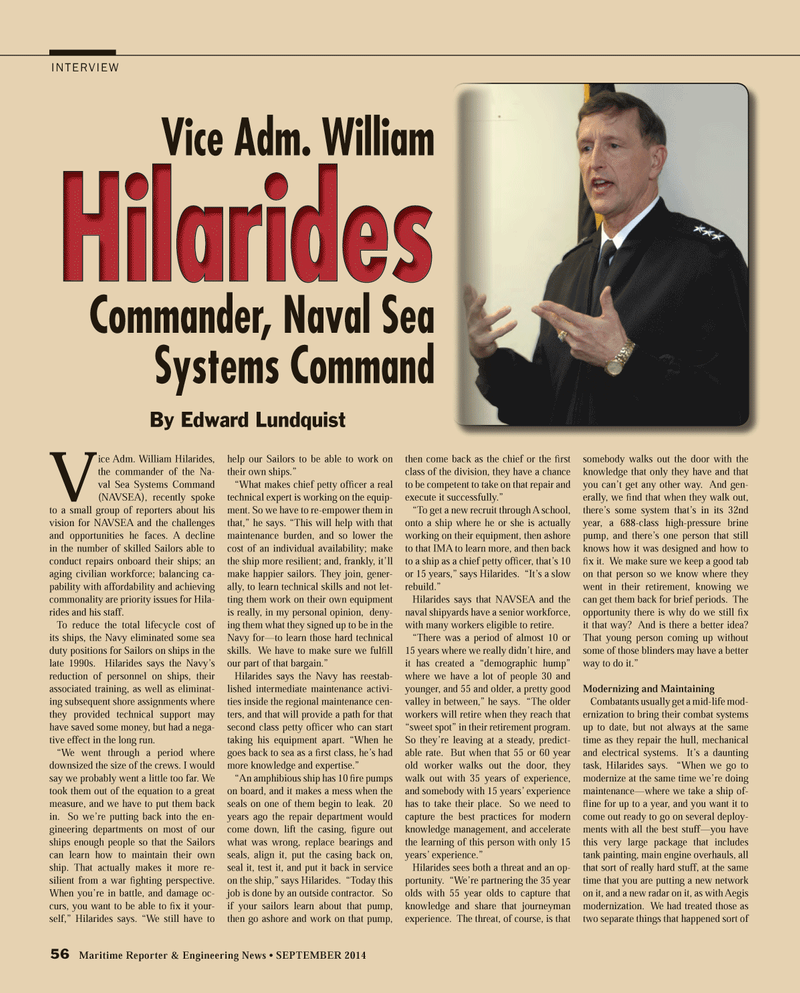
Page 56: of Maritime Reporter Magazine (September 2014)
Marine Propulsion Edition
Read this page in Pdf, Flash or Html5 edition of September 2014 Maritime Reporter Magazine
INTERVIEW
V ice Adm. William Hilarides, the commander of the Na- val Sea Systems Command (NAVSEA), recently spoke to a small group of reporters about his vision for NAVSEA and the challenges and opportunities he faces. A decline in the number of skilled Sailors able to conduct repairs onboard their ships; an aging civilian workforce; balancing ca- pability with affordability and achieving commonality are priority issues for Hila- rides and his staff.
To reduce the total lifecycle cost of its ships, the Navy eliminated some sea duty positions for Sailors on ships in the late 1990s. Hilarides says the Navy’s reduction of personnel on ships, their associated training, as well as eliminat- ing subsequent shore assignments where they provided technical support may have saved some money, but had a nega- tive effect in the long run. “We went through a period where downsized the size of the crews. I would say we probably went a little too far. We took them out of the equation to a great measure, and we have to put them back in. So we’re putting back into the en- gineering departments on most of our ships enough people so that the Sailors can learn how to maintain their own ship. That actually makes it more re- silient from a war fi ghting perspective.
When you’re in battle, and damage oc- curs, you want to be able to fi x it your- self,” Hilarides says. “We still have to help our Sailors to be able to work on their own ships.” “What makes chief petty offi cer a real technical expert is working on the equip- ment. So we have to re-empower them in that,” he says. “This will help with that maintenance burden, and so lower the cost of an individual availability; make the ship more resilient; and, frankly, it’ll make happier sailors. They join, gener- ally, to learn technical skills and not let- ting them work on their own equipment is really, in my personal opinion, deny- ing them what they signed up to be in the
Navy for—to learn those hard technical skills. We have to make sure we fulfi ll our part of that bargain.”
Hilarides says the Navy has reestab- lished intermediate maintenance activi- ties inside the regional maintenance cen- ters, and that will provide a path for that second class petty offi cer who can start taking his equipment apart. “When he goes back to sea as a fi rst class, he’s had more knowledge and expertise.” “An amphibious ship has 10 fi re pumps on board, and it makes a mess when the seals on one of them begin to leak. 20 years ago the repair department would come down, lift the casing, fi gure out what was wrong, replace bearings and seals, align it, put the casing back on, seal it, test it, and put it back in service on the ship,” says Hilarides. “Today this job is done by an outside contractor. So if your sailors learn about that pump, then go ashore and work on that pump, then come back as the chief or the fi rst class of the division, they have a chance to be competent to take on that repair and execute it successfully.” “To get a new recruit through A school, onto a ship where he or she is actually working on their equipment, then ashore to that IMA to learn more, and then back to a ship as a chief petty offi cer, that’s 10 or 15 years,” says Hilarides. “It’s a slow rebuild.”
Hilarides says that NAVSEA and the naval shipyards have a senior workforce, with many workers eligible to retire. “There was a period of almost 10 or 15 years where we really didn’t hire, and it has created a “demographic hump” where we have a lot of people 30 and younger, and 55 and older, a pretty good valley in between,” he says. “The older workers will retire when they reach that “sweet spot” in their retirement program.
So they’re leaving at a steady, predict- able rate. But when that 55 or 60 year old worker walks out the door, they walk out with 35 years of experience, and somebody with 15 years’ experience has to take their place. So we need to capture the best practices for modern knowledge management, and accelerate the learning of this person with only 15 years’ experience.”
Hilarides sees both a threat and an op- portunity. “We’re partnering the 35 year olds with 55 year olds to capture that knowledge and share that journeyman experience. The threat, of course, is that somebody walks out the door with the knowledge that only they have and that you can’t get any other way. And gen- erally, we fi nd that when they walk out, there’s some system that’s in its 32nd year, a 688-class high-pressure brine pump, and there’s one person that still knows how it was designed and how to fi x it. We make sure we keep a good tab on that person so we know where they went in their retirement, knowing we can get them back for brief periods. The opportunity there is why do we still fi x it that way? And is there a better idea?
That young person coming up without some of those blinders may have a better way to do it.”
Modernizing and Maintaining
Combatants usually get a mid-life mod- ernization to bring their combat systems up to date, but not always at the same time as they repair the hull, mechanical and electrical systems. It’s a daunting task, Hilarides says. “When we go to modernize at the same time we’re doing maintenance—where we take a ship of- fl ine for up to a year, and you want it to come out ready to go on several deploy- ments with all the best stuff—you have this very large package that includes tank painting, main engine overhauls, all that sort of really hard stuff, at the same time that you are putting a new network on it, and a new radar on it, as with Aegis modernization. We had treated those as two separate things that happened sort of
Vice Adm. William
Commander, Naval Sea
Systems Command
By Edward Lundquist 56 Maritime Reporter & Engineering News • SEPTEMBER 2014
MR #9 (50-57).indd 56 9/3/2014 10:53:16 AM

 55
55

 57
57
